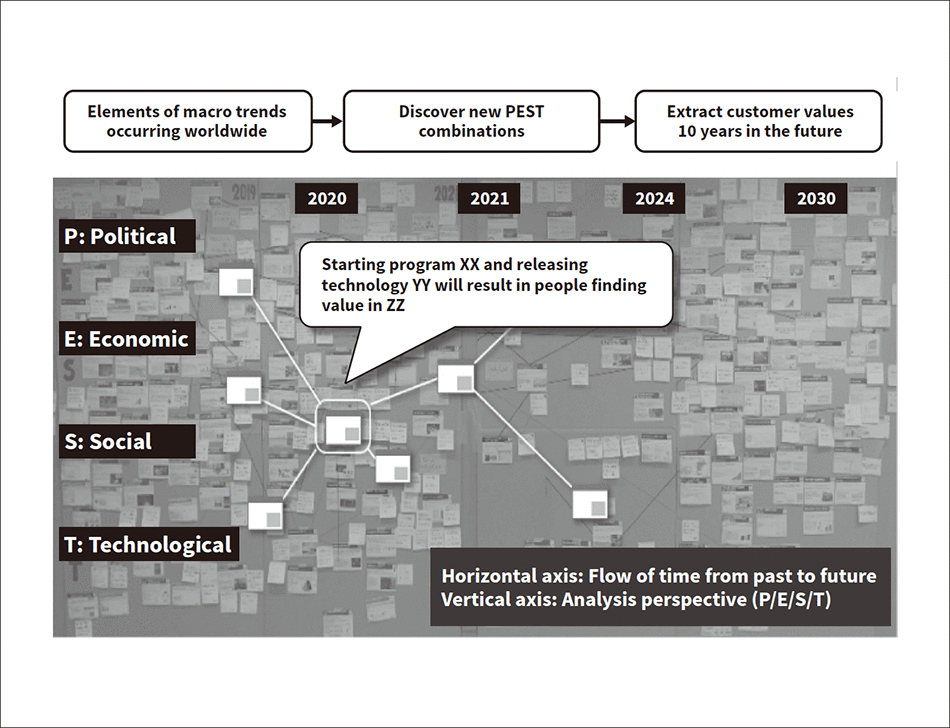Smart Life Solutions that Improve Quality of Life by Solving Societal and Lifestyle IssuesVision-driven Solution Development Strategy
Highlight
Today’s drastically changing customer lifestyles, social environment, and competitive environment in the world are making it increasingly difficult to release competitive products and services just by continuing to make small improvements to existing items or by analyzing current conditions to create conventional forecasts that predict the future. Hitachi Global Life Solutions, Inc. is adopting a set of vision-driven development processes that use the backcasting approach. Backcasting involves anticipating the world and lifestyles of the future, and the values of customers in the future. The results are used to infer needs that will arise, so that the specifications and technologies of tomorrow’s products and services can be derived. By adopting these vision-driven development processes, the company wants to become a people-focused solutions company that creates appealing value ahead of competitors.

1. Introduction
Hitachi Global Life Solutions, Inc. (Hitachi GLS) is a Hitachi Group member working in the Smart Life sector and aiming to become a solutions company that enriches the quality of life (QoL) of people around the world by solving customer lifestyle-related issues. The company has started to adopt a set of vision-driven product/service development processes as a way to release appealing value ahead of competitors by leveraging the experience and track record it has gained from its conventional home appliance and air conditioning businesses.
This article describes Hitachi’s backcasting-based vision-driven product/service development processes and an original Hitachi method of identifying future trends called Kizashi*.
- *
- The Kizashi method was devised in 2010 by Hitachi’s Global Center for Social Innovation as a research method for identifying future trends related to Social Innovation Business. It is currently used for developing new business areas either within Hitachi or as part of client collaborative creation projects done with partner companies.
2. Work on New Development Processes
Fig. 1—Backcasting-based Product Development Starting from a vision, backcasting derives policies for new business areas and technologies that should be developed over the medium to long term.
Starting from a vision, backcasting derives policies for new business areas and technologies that should be developed over the medium to long term.
Aging population, declining birth rate, and growing number of dual-income and single-member households are transforming family life, approaches to household chores, and other customer attitudes and behaviors. Customers are also buying home appliances in new ways as electronic commerce (e-commerce) websites become increasingly popular shopping sites alongside brick-and-mortar stores. Some home appliances have recently started supporting the Internet of Things (IoT) and are increasingly being used with smartphone app services, while subscription services and services connecting different businesses have also appeared. The approach to providing products and services is also shifting from the conventional hardware sales-based model, to models involving ongoing relationships with customers such as operation or maintenance provided by digital means.
These trends have produced an urgent need for the creation of product- and service-based solutions that play a large role in customer lifestyles, address latent lifestyle issues, and are first to identify issues that will arise as the societal changes in the future.
Hitachi GLS has responded by starting to adopt a set of vision-driven product development processes that use the backcasting approach. Backcasting involves creating a vision depicting the preferred lifestyles of customers 10 years in the future, and using the results to infer the needs that will arise, so that the specifications and technologies of tomorrow’s products and services can be derived (see Figure 1).
The visions created with backcasting are developed by identifying future signs of potential changes in customer and societal values and are used by HitachiGLS to develop attractive solutions that will suit those future customers. The products and services described for these visions are shared as future targets with development staff, and product/service master plans and technology roadmaps are created and incorporated into research and development. At the same time, the business planning or sales department gets involved with the project to start researching business feasibility.
3. Hitachi’s Kizashi Method
The Kizashi method is an original Hitachi method HitachiGLS uses to identify future trends based on future changes in the values held by customers(1), (2).
The Kizashi method starts with the collection of environmental analysis data on political, economic, social, technological factors. These data sets are then combined to anticipate the future and extract changes in customer values in the form of precursors (kizashi in Japanese). The new lifestyles that could arise from the changes identified are defined, and the corresponding business opportunity areas are envisioned so that appealing solutions can be devised. Some of these processes are described in the next section (see Figure 2).
Fig. 2—Kizashi Method The Kizashi method is a method of analyzing data and generating ideas from source information that covers a wide range of areas such as policies, market estimates, and other economic trends, customer product demand surveys, and forecasts on the rise of cutting-edge technologies.
The Kizashi method is a method of analyzing data and generating ideas from source information that covers a wide range of areas such as policies, market estimates, and other economic trends, customer product demand surveys, and forecasts on the rise of cutting-edge technologies.
4. Examples of Precursors and New Lifestyles
Yearly data on average household size given by standard statistical population surveys show trends such as the growth of single-member households and senior households. But identifying today’s diversifying consumer trends and lifestyle attitudes requires a qualitative method of classifying consumers based on differences in values that cannot be categorized by demographics alone. The precursors of the future derived by Kizashi method may provide an effective way of classifying consumers.
Looking at the macro trends of demographic changes, growing urbanization, and reduction of environmental impact, Hitachi GLS worked on identifying future trends up to about 2028. The new lifestyles the company came up with are described by the consumer categories below. These consumers will be passionate about living lifestyles that reflect their personal identities, and will emerge mainly in urban areas.
- Co-singles (single-family-member cluster)
- Members of this cluster prioritize their own personal values, are good at making use of their preferred services and personal relationships, and enjoy a life of skillfully overcoming the anxiety and inconvenience of social isolation. They tend to live alone. This cluster contains affluent seniors, young people choosing to remain unmarried, and couples living together in one household without commingling finances (new dual income, no kids [DINK] households).
- Designed Families (new/small household cluster)
- Members of this cluster prioritize family values. They live freely, avoiding stresses on the household by changing their living environment as needed to adapt to life events. They are mainly small households of two or three members. They include young families that can easily adapt to changes of environment, and seniors enjoying free time after raising children.
While clothing, food, and shelter are the three traditional areas of lifestyle focus, Hitachi GLS has added two more areas—health and work. Th e ‘health’ area looks at health, and mental and physical healthcare. Aging population has made it an area of greater concern. Th e ‘work’ area was added because today’s increasingly diverse work styles and workers may mean that the workplace and ways of spending time at work should naturally be considered aspects of lifestyle. Some examples of precursors of the future (new values) are described in the excerpts below (see Figure 3).
- Connected Urban Soloists (clothing, food, shelter, and work areas)
Singles and small households good at making connections by using multiple service networks
A group of consumers with well-defined values will arise as single-member and small households come together in urban areas with well-developed infrastructure for jobs, leisure, healthcare, and the like. Products and services designed to compensate for the inconvenience of living alone will appear, and consumers will select and make full use of products adapted to the lifestyles they are passionate about. - Narrative Foodism (food and health areas)
Enjoy meals with stories
Along with a rise in food literacy (ability to understand food components and benefits), food styles will also diversify in response to innovations in food processing technologies and cultural factors such as religions and beliefs. There will be an increase in consumers who view food ingredients as a hobby or pastime, and enjoy taking part in personal experiences related to them. Examples of these experiences could include personal participation in production, or taking an interest in particular purchasing routes. There might also be people who give rise to a new type of eating disorder that inhibits people from worry-free consumption of particular foods when not well-informed enough for their own peace of mind. - Work & Life Mosaics (work area)
Mosaics of work and housework –Realizing work, family, and community to the fullest
As Japan’s declining working-age population creates worsening labor shortages and work styles become more diverse, government and businesses will be forced to make fundamental work style reforms. There will be greater growth in the number of people who choose work styles that flexibly combine different working hours and tasks, such as freelancers and gig workers (people who work a series of odd jobs). Individually optimized working styles tailored to the worker’s living environment and values will be normalized, eventually resulting in lifestyles that piece together a mosaic of multiple jobs and housework chores in a single day. - Meals for All (food and health areas)
Eating together is living together
Social media sites will see further growth of personal communication from users seeking those with similar views on food, along with growth of new dining service information that can be filtered by personal preference to generate a lot of interest. As information optimization advances on a daily basis, interest will grow along with segmentation. Communities of people sharing common food values will form as a result, possibly causing a shift in values toward tolerance of food-sharing among non-family members. At the same time, problems such as food allergies and eating disorders of the elderly such as dysphagia and chewing disorders may become recognized as major issues of public concern. There may also be an increase in technological innovations for new universal-design foods created using taste, texture, and component-control technologies.
Fig. 3—Precursor Examples Each of the precursors of the future that Kizashi method derives is a set composed of keywords created from the consumer’s perspective, a narrative of changing values, and evidentiary data.
Each of the precursors of the future that Kizashi method derives is a set composed of keywords created from the consumer’s perspective, a narrative of changing values, and evidentiary data.
5. Conclusions
This article has described Kizashi, Hitachi’s original method of identifying future trends related to lifestyle and housework solutions. Along with the areas currently covered by Kizashi, Hitachi GLS may also need to expand its scope to include aspects such as new digital-era product/service purchasing behaviors, and the role of maker culture and prosumers in future production and distribution.
Anticipating multiple aspects of the future from the customer perspective to identify changing customer values (precursors of the future) is an important marketing activity for planning and developing products and services. It is also an important step toward creating a vision that depicts the type of company Hitachi should try to be, and the type of future customers want.
By adopting vision-driven development processes, Hitachi GLS will continue striving to create new value ahead of competitors and proposing appealing products and services to customers around the world. It also wants to grow as a company that works to improve the QoL of the employees and development partners who generate this value, that provides social value such as by reducing environmental impact, and that helps ensure sustainability.
REFERENCES
- 1)
- Y. Maruyama et al., “Studies of Methodology that Help to Design Future Experience,” Hitachi Review, 62, pp. 344–351 (Sep. 2013).
- 2)
- T.Akashi et al.:Kizashi Method-Grasping the change of future user’s values-,Serviceology for Desining the Future,481-494(2014)






